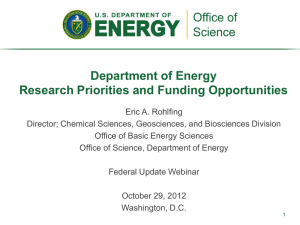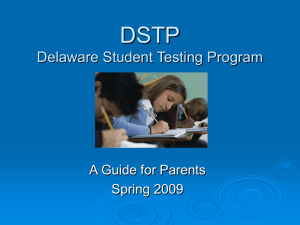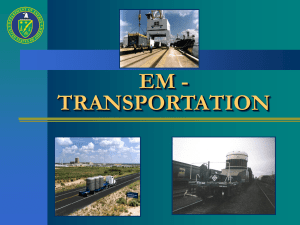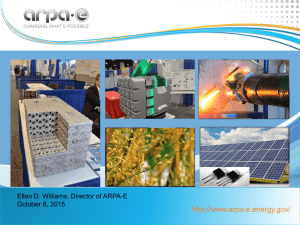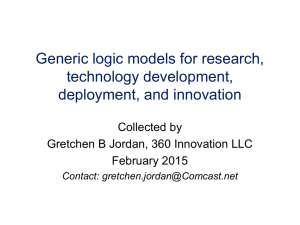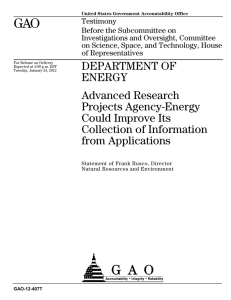Meeting Agenda - Research and Economic Development
advertisement
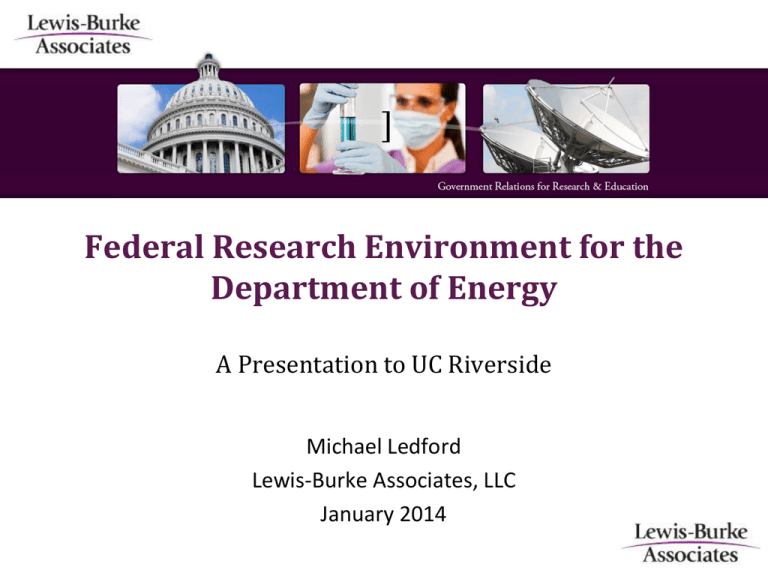
] Federal Research Environment for the Department of Energy A Presentation to UC Riverside Michael Ledford Lewis-Burke Associates, LLC January 2014 Lewis-Burke Associates, LLC Lewis-Burke Associates, LLC is a leading full-service government relations firm specializing in advocating for the public policy interests of institutions of higher education and other research and education organizations • Began working with UC Riverside in November 2012 • 23 professional staff members • 26 clients, all nonprofits involved in research and/or education – 15 universities – 3 contractors running national research facilities – 8 associations 2 Department of Energy • New Secretary of Energy Ernie Moniz proposes reorganizing DOE and is pushing to fill vacancies in political jobs, including a consolidated Under Secretary for Science and Energy and the Director of the Office of Science • Energy research is a key priority of the Obama Administration to advance policy goals (energy security and independence, climate change, advanced manufacturing, sustainability, and innovation) • Discovery science, such as HEP, Nuclear Physics, and Fusion, must compete for funding with ASCR, BES, and BER, which support these goals • The DOE Office of Science budget has also been squeezed by the Obama Administration’s creation of new innovation models – the Energy Innovation Hubs, Energy Frontier Research Centers (EFRCs), and ARPA-E • The Office of Science must also compete with DOE clean energy programs as the President proposes significant new investments in Energy Efficiency and Renewable Energy (EERE) technology programs 3 Research Roadmaps • DOE’s Office of Basic Energy Sciences has published a series of Basic Research Needs workshop reports that continue to inform funding opportunities across the DOE complex, including the Office of Science (http://science.energy.gov/bes/news-and-resources/reports/) • Program offices within the Office of Energy Efficiency and Renewable Energy have published roadmaps or reports to outline the research questions for its field – wind energy; solar; biomass/bioenergy; fuel cells; geothermal; technology offices for industrial, buildings and vehicles focus on key research areas to advance technology commercialization • ARPA-E hosts invitation only workshops, issues Requests for Information, and occasional open calls for proposals to inform new research programs • As a mission agency, DOE needs to know you and your research; it is important to participate in RFIs, submit white papers in response to funding opportunities, and be invited to, and participate in, workshops 4 DOE Office of Science FY 2013 Enacted FY 2014 Request DOE, total 27,043,427 28,953,893 Science 4,876,000 5,152,752 440,825 465,593 1,689,495 1,862,411 Biological and Environmental Research Fusion Energy Sciences Program High-energy Physics 610,196 625,347 401,108 458,324 789,595 776,521 Nuclear Physics 548,537 569,938 18,451 16,500 111,503 97,818 Advanced Scientific Computing Research Basic Energy Sciences Workforce Development for Teachers and Scientists Science Laboratories Infrastructure 5 FY 2014 Senate Subcom Mark (vs. FY 2013) 28,209,862 (4.3%) 5,152,752 (5.7%) 493,773 (12.0%) 1,805,162 (6.9%) 625,347 (2.3%) 458,324 (14.3%) 806,590 (2.2%) 569,938 (4.0%) 16,500 (-10.6%) FY 2014 House Cmte Mark (vs. FY 2013) 24,952,252 (-7.8%) 4,653,000 (-4.6%) 432,365 (-1.9%) 1,583,099 (-6.3%) 494,106 (-19.0%) 506,076 (26.2%) 772,521 (-2.2%) 551,953 (0.6%) 16,500 (-10.5%) 97,818 (-12.3%) 46,558 (-58.3%) Office of Science Programs • ASCR – Priority for Secretary Moniz is to pursue exascale computing and data-intensive science, which will require collaboration among application programmers, computer scientists, and hardware designers (see March 2013 report on Synergistic Challenges in Data-Intensive Science and Exascale Computing) • BES – Has led Obama Administration innovation initiatives, hosting two Energy Innovation Hubs and funding the EFRCs. User facilities have been important part of Administration’s emphasis on public-private partnerships for technology innovation. Emphasizes materials science and techniques to engineer and control chemical, geological and biochemical processes to develop new clean energy technologies • BER – Continues to support three Bioenergy Research Centers. Climate modeling areas of focus include the tropics and Arctic and new observations of clouds, aerosols, and sensitive ecosystems. Congressional Republicans regularly aim to reduce funding for BER due to its climate 6 change function. Office of Science (cont.) • High Energy Physics -- DOE Office of High Energy Physics (HEP) is in a holding pattern as the community undertakes a new strategic planning process through P5, which is scheduled to report by May 1 • Nuclear Physics – As with BES and HEP, NP community went through a major strategic planning exercise to direct future research; report has been well received and has community buy-in – Research fits with DOE emphasis on developing techniques to manipulate matter at the atomic level to create new materials and techniques to make advances in technology development • Fusion Energy Sciences – U.S. commitment to the ITER (International Thermonuclear Experimental Reactor) project in France has squeezed the Office of Science budget and domestic fusion facilities. Administration continues to grapple with this funding demand 7 High Energy Physics • The FY 2015 budget request will be submitted before the final P5 report is released and the community can respond, making it unlikely that the Administration will propose major new programs • FY 2015 budget will resubmit new starts that have been delayed by funding under Continuing Resolutions • At the December HEPAP meeting, Dr. Pat Dehmer called out two major demands in the HEP program -- interest in pursuing the Long Baseline Neutrino Experiment (LBNE) and the upgrades to the Large Hadron Collider (LHC) in the 2017-2018 period • In a charge to the Office of Science from OMB to assess all facilities in order to develop a ten-year prioritization plan across the Office overall, Dr. Dehmer said HEP stood out with the potential big funding wedge • Her message was that P5 and the HEP community have a very significant challenge in developing a program plan within anticipated budgets 8 HEP Update • At HEPAP, Jim Siegrist pointed to the exciting new results invigorating HEP – the discovery of the Higgs; the theta 1-3 measurement for neutrinos; advances in dark matter detection; and advanced accelerator R&D • Challenges – ramping down existing projects and research to invest in new projects only to be caught in sequestration (LBNE; LHC detector upgrades; 2nd generation Dark Matter detectors), and a Continuing Resolution delaying new starts (LSST; Muon g-2; Belle II) • With budget agreement and a likely FY 2014 omnibus appropriations bill, some of these issues will be addressed • FY 2014 President’s budget request and the House and Senate appropriations recommendations for HEP are all above the FY 2013 postsequester level • There will be continued tensions within DOE in allocating funding among programs within the Office of Science and with EERE and ARPA-E 9 Update on HEP Comparative Reviews • DOE received 134 applications for funding among six HEP subprograms: intensity frontier (26 proposals); HEP Theory (33); Accelerator Science and Technology R&D (31); Particle Detector R&D (14); energy frontier (20); and cosmic frontier (28); review panels met in mid-November • DOE used the new Portfolio Analysis and Management System (PAMS) • Panels assessed merits of senior investigators; scientific/technical merit of project; proposed method; competency of research team/adequacy of resources; reasonableness of budget; relevance to OHEP mission • PIs receive guidance and funding levels in mid-January with funded grants to begin about May 1 • DOE will transition to full-funding of multi-year grants and cooperative agreements from universities with a total cost of less than $1 million • Full funding will be obligated for those grants at the time of the award with continued annual performance reviews/reports prior to receiving next-year funding 10 ARPA-E • • • • • 11 ARPA-E has received bipartisan support in the Congress with its emphasis on supporting high-risk, high-reward R&D leading to new energy technologies With an annual budget of about $300 million, ARPA-E has focused on two major sectors – transportation and large-scale energy storage Programs are developed through workshops (invitation only); Requests for Information (RFIs) to the community on specific topics; and occasionally through an open call for innovative proposals ARPA-E provides teaming opportunities, asking researchers to volunteer to team on specific funding opportunities; universities have done very well competing for ARPA-E funding Annual Energy Innovation Summit is scheduled in Washington on February 24-26; great networking opportunity with ARPA-E program managers and other federal agency research program officers (http://arpa-e.energy.gov/?q=photo/2014-arpae-energy-innovation-summit-infographic) Energy Efficiency and Renewable Energy (EERE) • • • • • • • 12 DOE technology programs through EERE have been a high priority for President Obama to create clean, renewable energy technologies, save energy, and develop sustainable transportation Funded at about $2 billion annually, these applied technology programs are often geared toward partnerships with business and industry to collaborate on the creation of new, commercially competitive energy technologies Programs are generally open to universities, but preponderance of EERE funding is awarded to business and industry; requires cost-sharing (20 percent R&D and up to 50 percent demonstration and deployment); seek private sector partners Universities participate in the solar decathlon and have been funded through the Sunshot program seeking to make solar cost competitive Universities have successfully sought funding through the wind energy program, now focused on developing offshore wind energy; also funds workforce training Potential power sources from Geothermal energy and Marine and Hydrokinetic are newer renewable resources under investigation by EERE EERE also has the lead on hydrogen and fuel cell applied technologies EERE (cont.) • • • • • 13 Advanced Manufacturing program has been reoriented to Administration priority of reinvigorating U.S. manufacturing and improving energy consumption and other manufacturing processes This office is part of the President’s NNMI (National Network for Manufacturing Innovation), and also supports the Advanced Manufacturing Partnership and Innovative Manufacturing Initiative – emphasis on public-private partnerships Vehicles Technologies continue to focus on developing and deploying advanced vehicle technologies, including electric vehicles (President’s EV Everywhere Grand Challenge) This program also focuses on engine efficiency; batteries and energy storage ; power electronics; and lightweight materials; goal is to reduce fuel usage and reduce GHG emissions to tackle climate change EERE is lead DOE office to develop bioenergy sources, including algal biofuels. DOE takes lead on the bioenergy chain, including feedstock supply and logistics, conversion technologies, sustainability, and supports biorefinery pilot and demonstration projects National Nuclear Security Administration • NNSA’s primary mission is to secure and modernize the nation’s nuclear stockpile, maintain its deterrent capability, secure vulnerable nuclear materials, and carry out nuclear non-proliferation activities. • NNSA supports university researchers to help train the nuclear workforce needed at its national labs • The Stewardship Science Academic Alliances Program funds university research in areas important to the NNSA mission, especially stockpile stewardship • These areas include materials under extreme conditions (condensed matter physics and materials science, hydrodynamics, and fluid dynamics); low energy nuclear science; radiochemistry; and high energy density physics 14 Looking Ahead • Universities have to adjust to changing science bureaucracy in a flat budget environment • R&D and basic research still a TOP priority on both sides of the aisle in Congress, but there is competition for limited dollars • Public-private partnerships will remain the favored mechanism for large-scale efforts • Increased compliance burden continues • Advisory committees still key to determining and influencing agency policy and research directions • Traditional research funding agencies are placing an increased emphasis on cooperative agreements (with shared milestones) for new initiatives 15 Contact Kaitlin Chell Lewis-Burke Associates LLC 1341 G Street, NW Eighth Floor Washington, D.C. 20005 e: kaitlin@lewis-burke.com p: 202.289.7475 f: 202.289.7454 www.lewis-burke.com 16
